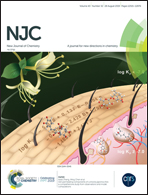Effect of ligand substituents on nickel and copper [N4] complexes: electronic and redox behavior, and reactivity towards protons†
Abstract
This paper describes the synthesis, and electronic and redox properties of three nickel(II) and two copper(II) complexes, namely, [Ni(L1)(Cl)2]·2H2O (1), [Ni(L2)(Cl)2]·H2O (2), [Cu(L2)(ClO4)]ClO4 (3), [Ni(L3)(Cl)2]·H2O (4), and [Cu(L3)(ClO4)]ClO4·2H2O (5). Ligands L1, L2 and L3 each contain a 1,2-bis((pyridine-2-ylmethyl)-azaneyl)ethane framework decorated with electron donating methyl and methyl/methoxy substituents. We observe a correlation between the electron donating capability of the ligands (L1 < L2 < L3) and the redox potential for the MII/MI couple (1 > 2 > 4 and 3 > 5). After thorough identification of the spectroscopic and redox properties of 1–5, the reactivity of the complexes was investigated towards proton and water reduction by means of electro and photocatalysis. These species seemingly support H2 evolution and display tunable catalytic properties achieved through the presence of differentiated electron donicity. Evidence of degradation with nanoparticle conversion was found to depend on the nature of both ancillary ligand and metal center.
![Graphical abstract: Effect of ligand substituents on nickel and copper [N4] complexes: electronic and redox behavior, and reactivity towards protons](/en/Image/Get?imageInfo.ImageType=GA&imageInfo.ImageIdentifier.ManuscriptID=C9NJ01283D&imageInfo.ImageIdentifier.Year=2019)


 Please wait while we load your content...
Please wait while we load your content...